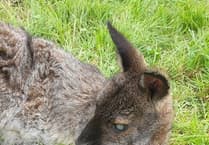A UK magazine with a global readership of around 1.6 million has sparked an online debate about what the Isle of Man should do with its growing population of wallabies.
The Economist highlighted the island’s Red-Necked Wallabies, which escaped from the Curraghs Wildlife Park in the 1960s and have since established themselves across parts of the island, particularly in the north and west.
Recent surveys by BH Wildlife Consultancy, in partnership with the Manx Wildlife Trust and commissioned by the Department of Environment, Food and Agriculture (DEFA), confirm that more than 1,000 wallabies now roam the island.
Populations have been detected in Ballaugh Curragh, Sulby Glen, Ramsey Forest, Tholt-y-Will, King’s Forest, and the western side of Ballaugh Glen. No wallabies were seen in Central Valley or Cooildarry.
While the animals have become part of the island’s identity, with a stuffed wallaby displayed at the Manx Museum, they pose ecological challenges.
Speaking to The Economist, Graham Makepeace-Warne, chief executive of the Manx Wildlife Trust, said: ‘Island ecosystems are always fragile.
‘The wallabies nibble native vegetation, disrupt local wildlife, and damage fences, causing farmers to grumble about lost livestock.’

Concerns have also been raised about their welfare.
Arno Wuenschmann, a veterinary pathology professor from the University of Minnesota, noted that the population suffers from a ‘genetic bottleneck’ and some individuals show visual impairments caused by parasitic infections.
Management options such as culling, fencing or sterilisation are all problematic.
Laura McCoy, curator of natural history for Manx National Heritage, said the Isle of Man could learn from Australia and New Zealand, where wallabies are treated as pests and controlled carefully.
The story in The Economist has drawn attention internationally, and sparked heavy debate online, prompting discussion about the balance between preserving native species, protecting the island’s ecology, and managing a now well-established, but non-native, marsupial population.




.jpeg?width=209&height=140&crop=209:145,smart&quality=75)